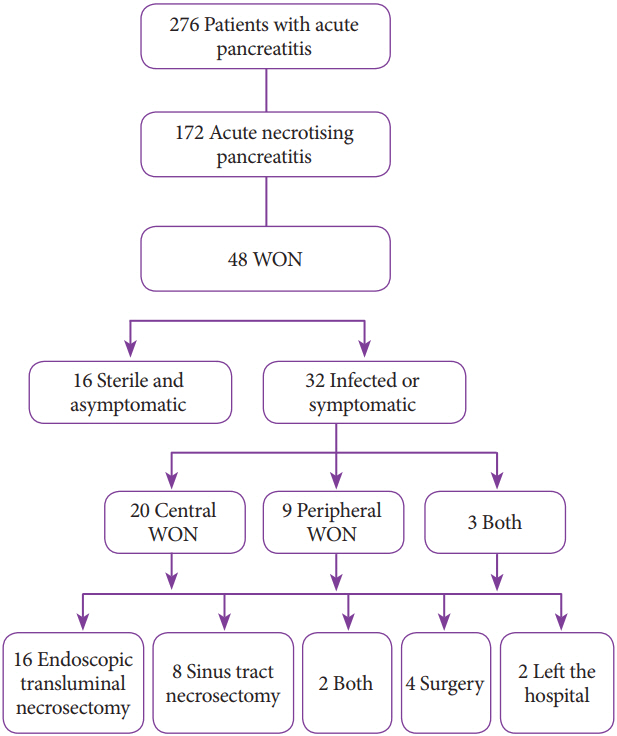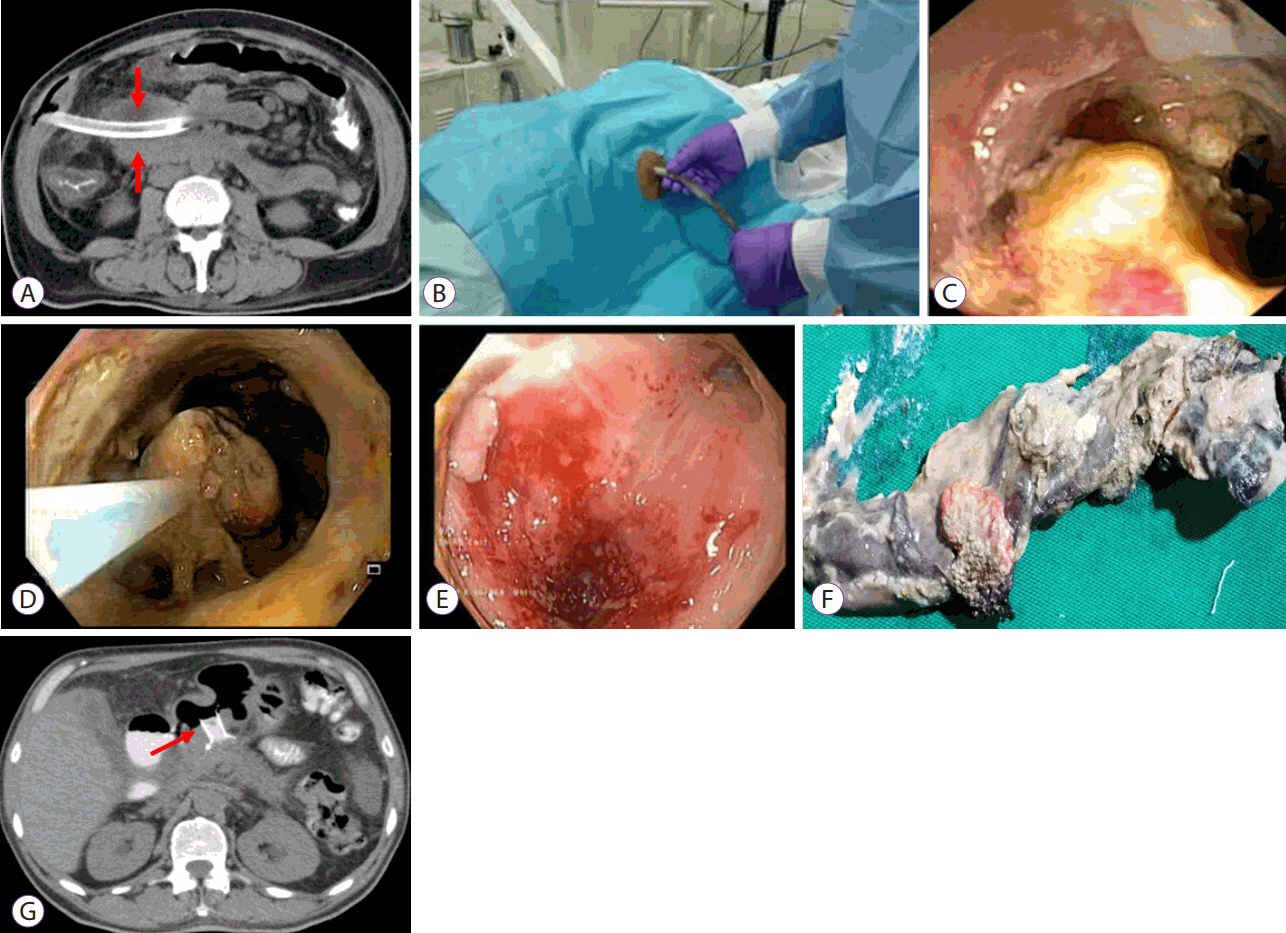Clin Endosc.
2018 May;51(3):279-284. 10.5946/ce.2017.066.
Pancreatic Necrosectomy through Sinus Tract Endoscopy
- Affiliations
-
- 1Institute of Gastrosciences, Apollo Gleneagles Hospitals, Kolkata, India. mkgkolkata@gmail.com
- 2Department of Clinical Imaging and Interventional Radiology, Apollo Gleneagles Hospitals, Kolkata, India.
- KMID: 2414870
- DOI: http://doi.org/10.5946/ce.2017.066
Abstract
- BACKGROUND/AIMS
Direct endoscopic pancreatic necrosectomy is increasingly being utilized to treat infected or symptomatic walled-off necrosis (WON) located close to the stomach or duodenum. Laterally-placed WON has traditionally been treated surgically. We evaluated a less utilized technique of sinus tract endoscopy (STE) for symptomatic laterally-placed WON.
METHODS
Two hundred seventy-six patients with acute pancreatitis admitted in our hospital, 32 had symptomatic or infected WON requiring intervention. Of the 12 patients with laterally placed WON, 10 were treated by STE. STE was performed with a standard adult gastroscope passed through a percutaneous tract created by the placement of a 32-Fr drain.
RESULTS
Ten patients (7 males; mean age, 43.8 years) underwent STE. Mean number of sessions was 2.3 (range, 1-4), with mean time of 70 minutes for each session (range, 15-70 minutes). While 9 patients had complete success, 1 patient had fever and chose to undergo surgery. Two patients developed pneumoperitoneum, which was treated conservatively. There was no mortality, cutaneous fistula, or recurrence during follow-up.
CONCLUSIONS
Laterally placed WON can be successfully managed by STE performed through a percutaneously placed drain. Details of the technique and end-points of STE require further evaluation.
MeSH Terms
Figure
Cited by 1 articles
-
Is Percutaneous Endoscopic Necrosectomy Really Safe and Effective for Symptomatic Laterally Placed Walled-off Necrosis?
Se Woo Park
Clin Endosc. 2018;51(3):213-214. doi: 10.5946/ce.2018.064.
Reference
-
1. Besselink MG, van Santvoort HC, Boermeester MA, et al. Timing and impact of infections in acute pancreatitis. Br J Surg. 2009; 96:267–273.
Article2. Petrov MS, Shanbhag S, Chakraborty M, Phillips AR, Windsor JA. Organ failure and infection of pancreatic necrosis as determinants of mortality in patients with acute pancreatitis. Gastroenterology. 2010; 139:813–820.
Article3. Whitcomb DC. Clinical practice. Acute pancreatitis. N Engl J Med. 2006; 354:2142–2150.4. Gloor B, Müller CA, Worni M, Martignoni ME, Uhl W, Büchler MW. Late mortality in patients with severe acute pancreatitis. Br J Surg. 2001; 88:975–979.
Article5. Garg PK, Madan K, Pande GK, et al. Association of extent and infection of pancreatic necrosis with organ failure and death in acute necrotizing pancreatitis. Clin Gastroenterol Hepatol. 2005; 3:159–166.
Article6. Tenner S, Baillie J, DeWitt J, Vege SS; American College of Gastroenterology. American college of gastroenterology guideline: management of acute pancreatitis. Am J Gastroenterol. 2013; 108:1400–1415. 1416
Article7. Freeman ML, Werner J, van Santvoort HC, et al. Interventions for necrotizing pancreatitis: summary of a multidisciplinary consensus conference. Pancreas. 2012; 41:1176–1194.8. Werner J, Hartwig W, Hackert T, Büchler MW. Surgery in the treatment of acute pancreatitis--open pancreatic necrosectomy. Scand J Surg. 2005; 94:130–134.9. Baron TH, Thaggard WG, Morgan DE, Stanley RJ. Endoscopic therapy for organized pancreatic necrosis. Gastroenterology. 1996; 111:755–764.
Article10. Seifert H, Wehrmann T, Schmitt T, Zeuzem S, Caspary WF. Retroperitoneal endoscopic debridement for infected peripancreatic necrosis. Lancet. 2000; 356:653–655.
Article11. Working Group IAP/APA Acute Pancreatitis Guidelines. IAP/APA evidence-based guidelines for the management of acute pancreatitis. Pancreatology. 2013; 13(4 Suppl 2):e1–e15.
Article12. Larvin M. Management of infected pancreatic necrosis. Curr Gastroenterol Rep. 2008; 10:107–114.
Article13. van Santvoort HC, Besselink MG, Bakker OJ, et al. A step-up approach or open necrosectomy for necrotizing pancreatitis. N Engl J Med. 2010; 362:1491–1502.14. Trikudanathan G, Attam R, Arain MA, Mallery S, Freeman ML. Endoscopic interventions for necrotizing pancreatitis. Am J Gastroenterol. 2014; 109:969–981. quiz 982.
Article15. van Santvoort HC, Bakker OJ, Bollen TL, et al. A conservative and minimally invasive approach to necrotizing pancreatitis improves outcome. Gastroenterology. 2011; 141:1254–1263.
Article16. Gluck M, Ross A, Irani S, et al. Endoscopic and percutaneous drainage of symptomatic walled-off pancreatic necrosis reduces hospital stay and radiographic resources. Clin Gastroenterol Hepatol. 2010; 8:1083–1088.
Article17. Ross AS, Irani S, Gan SI, et al. Dual-modality drainage of infected and symptomatic walled-off pancreatic necrosis: long-term clinical outcomes. Gastrointest Endosc. 2014; 79:929–935.
Article18. Bakker OJ, van Santvoort HC, van Brunschot S, et al. Endoscopic transgastric vs surgical necrosectomy for infected necrotizing pancreatitis: a randomized trial. JAMA. 2012; 307:1053–1061.
Article19. Mouli VP, Sreenivas V, Garg PK, et al. Efficacy of conservative treatment, without necrosectomy, for infected pancreatic necrosis: a systematic review and meta-analysis. Gastroenterology. 2013; 144:333–340. e2.
Article20. Runzi M, Niebel W, Goebell H, Gerken G, Layer P. Severe acute pancreatitis: nonsurgical treatment of infected necroses. Pancreas. 2005; 30:195–199.
Article21. Lee JK, Kwak KK, Park JK, et al. The efficacy of nonsurgical treatment of infected pancreatic necrosis. Pancreas. 2007; 34:399–404.
Article22. Hart PA, Baron TH. What is the role of noninvasive treatment for infected pancreatic necrosis: still an unanswered question. Gastroenterology. 2013; 144:1574–1575.
Article23. Seifert H, Biermer M, Schmitt W, et al. Transluminal endoscopic necrosectomy after acute pancreatitis: a multicentre study with long-term follow-up (the GEPARD study). Gut. 2009; 58:1260–1266.
Article24. Charnley RM, Lochan R, Gray H, O’Sullivan CB, Scott J, Oppong KE. Endoscopic necrosectomy as primary therapy in the management of infected pancreatic necrosis. Endoscopy. 2006; 38:925–928.
Article25. Rische S, Riecken B, Degenkolb J, Kayser T, Caca K. Transmural endoscopic necrosectomy of infected pancreatic necroses and drainage of infected pseudocysts: a tailored approach. Scand J Gastroenterol. 2013; 48:231–240.
Article26. Escourrou J, Shehab H, Buscail L, et al. Peroral transgastric/transduodenal necrosectomy: success in the treatment of infected pancreatic necrosis. Ann Surg. 2008; 248:1074–1080.27. Yasuda I, Nakashima M, Iwai T, et al. Japanese multicenter experience of endoscopic necrosectomy for infected walled-off pancreatic necrosis: The JENIPaN study. Endoscopy. 2013; 45:627–634.
Article28. Gardner TB. Endoscopic management of necrotizing pancreatitis. Gastrointest Endosc. 2012; 76:1214–1223.
Article29. Carter CR, McKay CJ, Imrie CW. Percutaneous necrosectomy and sinus tract endoscopy in the management of infected pancreatic necrosis: an initial experience. Ann Surg. 2000; 232:175–180.
Article30. Mui LM, Wong SK, Ng EK, Chan AC, Chung SC. Combined sinus tract endoscopy and endoscopic retrograde cholangiopancreatography in management of pancreatic necrosis and abscess. Surg Endosc. 2005; 19:393–397.
Article31. Dhingra R, Srivastava S, Behra S, et al. Single or multiport percutaneous endoscopic necrosectomy performed with the patient under conscious sedation is a safe and effective treatment for infected pancreatic necrosis (with video). Gastrointest Endosc. 2015; 81:351–359.
Article32. Abdelhafez M, Elnegouly M, Hasab Allah MS, Elshazli M, Mikhail HM, Yosry A. Transluminal retroperitoneal endoscopic necrosectomy with the use of hydrogen peroxide and without external irrigation: a novel approach for the treatment of walled-off pancreatic necrosis. Surg Endosc. 2013; 27:3911–3920.
Article33. Bucher P, Pugin F, Morel P. Minimally invasive necrosectomy for infected necrotizing pancreatitis. Pancreas. 2008; 36:113–119.
Article34. Ammori BJ. Laparoscopic transgastric pancreatic necrosectomy for infected pancreatic necrosis. Surg Endosc. 2002; 16:1362.
Article35. Horvath KD, Kao LS, Ali A, Wherry KL, Pellegrini CA, Sinanan MN. Laparoscopic assisted percutaneous drainage of infected pancreatic necrosis. Surg Endosc. 2001; 15:677–682.
Article36. Horvath KD, Kao LS, Wherry KL, Pellegrini CA, Sinanan MN. A technique for laparoscopic-assisted percutaneous drainage of infected pancreatic necrosis and pancreatic abscess. Surg Endosc. 2001; 15:1221–1225.
Article37. Freeny PC, Lewis GP, Traverso LW, Ryan JA. Infected pancreatic fluid collections: percutaneous catheter drainage. Radiology. 1988; 167:435–441.
Article38. Gambiez LP, Denimal FA, Porte HL, Saudemont A, Chambon JP, Quandalle PA. Retroperitoneal approach and endoscopic management of peripancreatic necrosis collections. Arch Surg. 1998; 133:66–72.
Article
- Full Text Links
- Actions
-
Cited
- CITED
-
- Close
- Share
- Similar articles
-
- Endoscopic Necrosectomy for Walled-Off Pancreatic Necrosis
- EUS-Guided Multitransgastric Endoscopic Necrosectomy for Infected Pancreatic Necrosis with Noncontagious Retroperitoneal and Peritoneal Extension
- Lumen apposing metal stents: A review of current uses and outcomes
- Endoscopic necrosectomy through a self-expandable metallic stent placed percutaneously for walled-off pancreatic necrosis
- Wernicke Encephalopathy after Endoscopic Necrosectomy in Acute Necrotizing Pancreatitis with WOPN: A Case Report



